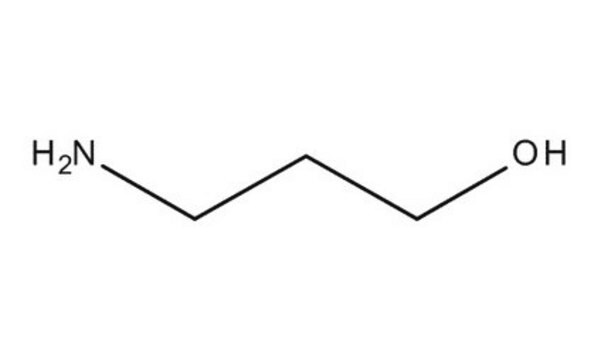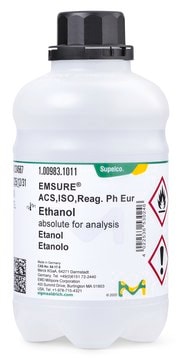8.00894
N-Ethyldiisopropylamine
for synthesis
Sinónimos:
N-Ethyldiisopropylamine, N,N-Diisopropylethylamine
About This Item
synthesis grade
Productos recomendados
grade
for synthesis
synthesis grade
Quality Level
vapor pressure
14 hPa ( 20 °C)
assay
≥98% (GC)
form
liquid
autoignition temp.
240 °C
potency
200-500 mg/kg LD50, oral (Rat)
expl. lim.
0.7-6.3 % (v/v)
dilution
(for synthesis)
pH
12.3 (20 °C in H2O, as an emulsion)
kinematic viscosity
0.88 cSt(20 °C)
bp
127 °C/1013 hPa
transition temp
flash point 9.5 °C
density
0.76 g/cm3 at 20 °C
storage temp.
2-30°C
SMILES string
N(C(C)C)(C(C)C)CC
InChI
1S/C8H19N/c1-6-9(7(2)3)8(4)5/h7-8H,6H2,1-5H3
InChI key
JGFZNNIVVJXRND-UHFFFAOYSA-N
Categorías relacionadas
General description
Application
- Dual Stimuli-Responsive Hybrid Polymeric Nanoparticles Self-Assembled from POSS-Based: Describes the synthesis of hybrid polymeric nanoparticles using N-Ethyldiisopropylamine in the assembly process (Yang et al., 2022).
- Magnetical Control of the Charge-Separated State Lifetime Realized by Covalent Attachment of a Platinum Complex: Details the use of N-Ethyldiisopropylamine in the preparation of magnetically controllable platinum complexes (Kozaki et al., 2021).
- Hybrid block copolymers of polyesters/polycarbonates and polypeptides synthesized via one-pot sequential ring-opening polymerization: Explains the initiation of polymerization with N-Ethyldiisopropylamine for creating hybrid block copolymers (Gradišar et al., 2018).
Analysis Note
Density (d 20 °C/ 4 °C): 0.755 - 0.758
Water (K. F.): ≤ 0.20 %
Identity (IR): passes test
signalword
Danger
Hazard Classifications
Acute Tox. 3 Inhalation - Acute Tox. 4 Oral - Aquatic Chronic 2 - Eye Dam. 1 - Flam. Liq. 2 - STOT SE 3
target_organs
Respiratory system
Storage Class
3 - Flammable liquids
wgk_germany
WGK 2
flash_point_f
49.1 °F
flash_point_c
9.5 °C
Certificados de análisis (COA)
Busque Certificados de análisis (COA) introduciendo el número de lote del producto. Los números de lote se encuentran en la etiqueta del producto después de las palabras «Lot» o «Batch»
¿Ya tiene este producto?
Encuentre la documentación para los productos que ha comprado recientemente en la Biblioteca de documentos.
Contenido relacionado
Fmoc resin cleavage and deprotection follows the difficult task of detaching the peptide from the resin support and removing all the side-chain protecting groups of the amino acid residues to yield the desired peptide.
Nuestro equipo de científicos tiene experiencia en todas las áreas de investigación: Ciencias de la vida, Ciencia de los materiales, Síntesis química, Cromatografía, Analítica y muchas otras.
Póngase en contacto con el Servicio técnico












